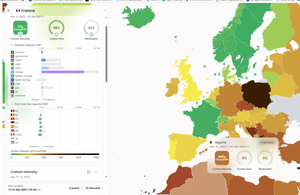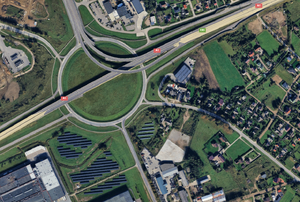
Siso
Members-
Posts
156 -
Joined
-
Last visited
Content Type
Profiles
Forums
Gallery
Downloads
Blogs
Events
Our Shop
Movies
Everything posted by Siso
-
The new stuff is huge, 330KV, possibly 500kV- Very expensive to build to only be used at low capacity factors. Remember, underutilised equipment is expensive. You don't see Qantas just having aircraft sitting around. An intermittent grid is going to have a lot of plant "laying" around for that once or twice a year when needed.
-
I disagree- I disagree:-https://www.re-alliance.org.au/where_are_the_lines_to_be_built plus the transmission lines needed from each farm to the closest major line. all these projects will be over budget as well. This is all extra because of the intermittency of our new generation. But at least we are being told the actual electricity is the cheapest form of electricity generation. Just the extras that make it expensive. We can see the price of coal fired generation rise as the capacity factor decreases. Do you reckon the same thing will happen with the intermittent generation as the overbuild eats into their capacity factors. During the months of high generation we can expect these generators to bid higher prices as their CF decreases due to oversupply. There is only so much extra energy that can be stored. This will also change during the year, pushing up the price of stored energy. Basic economics.
-
The transmission is not already there. Easily information found.SA has completed energy connect to the NSW border. Still waiting for NSW to do its half. Hume link is still being built and every time its mentioned its about another cost blowout. Plus all the large transmission needed to connect the renewable energy zones to the major centres. A fair bit of local resistance is happening for this projects. Would fix a lot of it if they actually put some WTG's in and around the citys. These are just the ones I know of off the top of my head. I heard a figure of 10,000km. Not just the transmission. see Snowy 2 is up to 12 billion, started at 2 and they are talking it may reach 20 billion. Traditional hydro is not the same as run of the river hydro. I love pumped hydro but it is only storage and when its empty that it. I think someone is playing the system with sun cable to Asia. Is Twiggy Forrest involved?
-
Pumped hydro does not make electricty, Iceland → virtually 100% renewables, advanced grid- Geo thermal. While Australia has some it is not accessible easily Norway → >95% renewables- Huge amount of traditional hydro Uruguay → ~95% renewables, stable and wealthy by South American standards-Huge amount of traditional hydro for size of grid approx 1.5GW Portugal → frequently >80% monthly renewable generation- interconnected, small demand/grid- looks like Max demand of 6MW Scotland → >100% wind generation equivalent to demand- interconnected with the UK, Australia has only about 7% traditional Hydro. A country of 26 million people is going to have to pay and build the Transmission infrastructure. I stand by: No One has ever done what Australia is trying to do with weather dependent intermittent generation on a grid the size of Australia. Gen cost has very rubbery figures. Give NP a life of 30 years. not true and easily founnd not to be true. A lot of NPP are having life extensions to 60 years, no reason not to believe new builds won't last 80- 100 years. France exports a lot more than it imports. UK imports more than it exports. Saying a region makes enough energy to support itself is also misleading. have a look at open nem shot from June this year, We weren't doing any where near 70% intermittents in SA but the publicity says we are for the year. See energymaps
-
That's OK then, we should "usually" have electricity then. Check out the wind drought around April to June 2024. https://wattclarity.com.au/articles/2024/06/13june-lowwind/ How much transmission are we going to have to build to Power Victoria from Queensland.
-
Denmark is not relevant for Australia. Australia has no France or Sweden. All these other countrys have small grids and are third world countrys. Would you like to live in Ethiopia or the Congo. I think not. Or there grids are majority conventional hydro. Australia has only 7% traditional hydro and not likely to get more. No One has ever done what Australia is trying to do with weather dependent intermittent generation on a grid the size of Australia. You are correct, we don't want coal, so the obvious answer is nuclear. We should start looking at it very seriously. We may have to work with coal again. Look how Germany is doing. France currently exporting approx. 12.5GW. Windy in UK, it is exporting 885MW to france and is exporting slightly more than it is importing exporting 3 importing 2
-
So where SA loses in having the cheapest form of energy, we will lose the savings in uderutilised infrastructure. We still dont know if it will work before the country goes broke. No one has ever built a grid on intermittent weather dependant renewables. It is criminal to even try when we have other proven options. Pity there wasnt a way to hold politicians to account for bad uninformed decisions they make while in power,
-
intermittents are cheap, SA should be closing the gap compared to other states. We are using less gas and we are at 70+% intermittents. Fossil fuels are yesterdays tech, but will need them for a while, ask Germany France exporting 13GW at the moment https://app.electricitymaps.com/map/zone/FR/live/fifteen_minutes
-
Intermittents are killing it in SA at the moment. Lots of wind and sun. Attached is from June this year. As you can see not so good. We need to build enough storage infrastructure to cover these times. A lot of this extra infrastructure we need will be sitting idle during this time of year. Do you think the owners will just say sht happens and just wear the loss or will they increase the price during the time when they will run. We use to have about 60GW of synchronous generation installed for about 30GW of max demand. When needed the reasonably cheap coal would look after it. Every thing would just load follow and during peak time the more expensive gas would cut in. Simple stable energy. If a PowerStation dropped out the rest had the inertia to ride through and throw a bit more power on the grid. We are already at 30GWs of intermittent generation and only at about a total of 40% intermittents and hydro. It is going to get harder and a lot more expensive as penetration increases. How come if intermittents are so much cheaper than traditional sources has SA got the dearest electricity in the country with the greatest number of intermittents? I realise it always has been dearer because of gas, surely it should have come down to at least be the same price. Open nem (1).pdf
-
Ho Hum, power bills up by 37%. Csiro also gave NP 40 year life, a big lie. Coal unreliablre because of demoniosation. Bad publicity for generators if they support it. Unfortunatley we still need it. Intermittent energy is cheap, its just all the underutised supporting infrastructure that is not. Will the last person out of Australia please turn off the lights.
-
All well and good to say a battery would have helped IF you can afford it. The current governments policy are directly making electricity more expensive for those people that can least afford it. The home battery scheme takes people out of the electricity market. This money is used for the extra transmission and infrastructure meaning the cost of electricity for those that can least afford it or those living in apartments / renters have to foot the bill or as has been happening, come out of general revenue with the money put against our power bills. Always thought the ALP use to support the battlers! The whole system is an expensive joke that is going to make very little difference to the worls CO2 system.
-
Coal is so much nicer than alternative energy sources, just look at this lovely coal mine. Compared to the ugly wind turbines in the distance. Not a fan of coal. I wander how many 1000's of years it would take those wind turbines in the back ground to make the same amount of energy that came from that coal mine, or how many wind turbines it would take to make the same amount energy with the same capacity factor and availability when needed.
-
I wouldn't like to hit a roo (or any animal larger then a sheep) in a tesla, low bonnet, may end up inside with you.
-
My first sentence in my first post was "Its still up in the air weather renewables are cheaper." Not saying they aren't cheaper
-
Please supply me with a link to the relative costs. No politician is being straight forward with it. Intermittents are the cheapest form of electricity if you forget about the extra transmission, battery's, artificial inertia and the considerable amount of underutilized gas backup. Being Aircraft type dudes on this site we realize underutiliseded plant is expensive, still need to do a hundred hourly every year weather you do 98 or 2 hours. Having a lot of inertia on the grid also reacts relatively quickly, has for a hundred years. Synchronous plants give a nice consistant sine wave. Inverters work by very fast switching and produce a steeped sinewave by switching on and of quickly. This is filtered to give a smooth wave form. Ask Spain what happens when an inverter starts acting up with little inertia on the grid.
-
Its still up in the air weather renewables are cheaper. We need to remember no one anywhere in the world has got close to net 0 using weather dependent intermittent generation. Look at Germany and they get some clean energy from there neighbors. Any one that has got close has either nuclear (France, Sweden Ontario), large amounts of Hydro(Norway, Quebec, Albania) or geothermal(Iceland.) Australia has no nuclear, maybe some hard to access geothermal and hardly any hydro. We have around 7% traditional hydro and are very unlikely to get much more. All the hydrogen plants that have started have gone belly up at I don't know what cost to the government. I have aske a sitting member in the government about this in SA but he isn't getting back to me. May have to send another reminder today. Hydrogen is mentioned in either gencost or the ISP as part of the big plan. I don't know how much of the coalitions policy is gaslighting but I think ditching net 0 by 2050 but keeping in with Paris is a good thing. Hopefully we get the gas price sorted out and we can actually start making things again here. Jobs for our kids, better environmental and workplace laws the some other countries and will save burning bunker oil in big ships sending stuff overseas and back again. This last one really makes the government look stupid. This whole CO2 thing is a global problem. Again, look at electrictymaps. France | App | Electricity Maps France exporting about 13GW of power at the moment. In the UK , a country that is trying to do a similar thing to Australia except they have interconnectors with other countrys, is burning about 20, 000 tonnes of woodchips a day, a lot of which they inport from America to say they are using clean energy. Wood has similar emissions to coal but at least with coal you aren't burning bunker oil in ships to bring it to your country (in the UK). Google Drax power plant. They have also canned looking for gas in the North Sea and instead are going to import from Norway. It is all smoke and mirrors. I don't what the CIS is going to cost us.(capacity investment scheme) If intermittents are so cheap, why all the schemes ect.
-
France exporting over 15GW at the moment, must not be much sun or wind. France | App | Electricity Maps
-
Well known personalities who have passed away recently (Renamed)
Siso replied to onetrack's topic in General Discussion
He was put on a lot of the radio stations in SA for quite a few years as well -
Talking to someone the other days who's lad is pretty up in moto x. The electric bikes smash the equivalent horse power 250 class. No gear changes and the torque is constant all through the rev range.
-
We had a couple put in a local town. Everyone winged about how bad it was going to be including me. Once everyone got use to it, it was great. Adelaide has the Britannia roundabout that was a nightmare. Parklands association wouldn't let them have anymore land for a set of lights, so know there are 2 round abouts and still a nightmare Probably OK once you get used to it unless you are there when someone isn't. Klaipeda, Lithuania below, 200 m across, not much fun changing lanes as you go around in peak hour when you don't really know where you are going, especially when everyone drives on the wrong side of the road.( the right side) Locals seem to handle it ok though.
-
I think SA is it 77% but it hangs of interconnectors from Victoria that can handle its whole demands a lot of the time. Bit like Germany hanging off France and Sweden. SA probably has the smallest demand in the country(maybe Tassie) 1/4 of the size of Vic, NSW and Qld. I think Australia is about 40%. We are just seeing market notices for NSW from AEMO directing plant to start for grid stability (https://wattclarity.com.au/articles/2025/10/20oct-nsw-systemstrength/) SA has had that for a few years. Guess who pays for that. The generator doesn't do this for free. Another hidden cost for the cheapest form of electricity. Massive coal mines are normally in one place for several GW's of generation not visible in every direction as far as the eye can see. I agree, the odd windfarm here and there looks ok but it is getting out of control. Went to the Ignalina nuclear plant for a look when I was overseas. You didn't even know it was there except for the large pipes on the side of the road (probably used for district heating until you were at the front gate.(no cooling tower) This plant was designed for 4.5 GW's of electricity. (only 3 was finished) It was nestled in the trees. 3 GW is about 600 5 MW wind turbines(136m tower, 150m + rotor) x 2.5 for the capacity factor. (1400) plus whatever you need for the wind droughts etc.
-
There is no such thing as free power!
-
I have no problem with windfarms, worked on them for over 10 years. People in the district are just sick of them being on every hill in every direction you look. Like city people wing when high rises go up next door. And we are doing this as an experiment. No one has ever run a grid the size of Australia's on weather dependent generation before. (Australia only has about 7% traditional hydro and unlikely to get more. Some turbines are easily intergrated into a grid. Once you get above 40% the problem start. Good for saving fuel for GT's and coal powered stations.
-
Windmills aren't sitting on 150m towers with 162m rotor. They are generally only 30 feet high. Windmills are also not built in large numbers over every hill in site. (unless you live in a city). Not remotely the same thing.
-
I am talking MW turbines, not toys , pretty sure it is about votes. The majority of people that vote for them live in the citys so they should put up with them. Copenhagen have them everywhere you look around the city. The one in London looks pretty cool. The main word in the last sentence is one. The odd windfarm strewn around the place was OK, but it is just getting out of control. People live in the country to get away from all the industry and ugly built up city views. To do this they make sacrifices like no public transport, 100Km to the closest services SA etc. I came over a hill in the midnorth of SA last Wednesday morning and there was 500MWs of wind in front of me and not one was turning.








